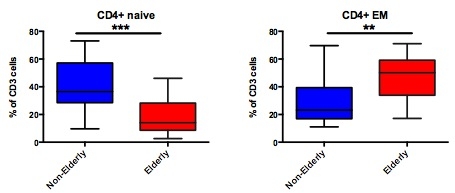Evaluation of T Cell Immunity in Elderly Solid Organ Transplant Recipients.
1Department of Medicine, David Geffen School of Medicine at UCLA, Los Angeles, CA
2Department of Pathology, David Geffen School of Medicine at UCLA, Los Angeles, CA.
Meeting: 2016 American Transplant Congress
Abstract number: C272
Keywords: Elderly patients, Kidney transplantation, T cells
Session Information
Session Name: Poster Session C: Poster Session 1: Kidney Complications-Other
Session Type: Poster Session
Date: Monday, June 13, 2016
Session Time: 6:00pm-7:00pm
 Presentation Time: 6:00pm-7:00pm
Presentation Time: 6:00pm-7:00pm
Location: Halls C&D
Elderly transplant recipients experience increased rates of death, especially death due to infection, as compared with younger patients. However, little is known about the mechanism of increased rates of infection and death.
Methods: Peripheral blood mononuclear cells were isolated from 34 kidney transplant recipients 3 mo. post-transplant; elderly and non-elderly patients were matched on transplant type and induction therapy. Immune phenotyping was performed by multiparameter flow cytometry, and for CMV immune response intracellular cytokine secretion was used, with overlapping peptide pools of CMV antigens for stimulation.
Results: Elderly (≥65 yo) kidney transplant recipients had a statistically significantly lower frequency of naïve CD4+ T cells (14.1% versus 36.6% in younger patients, p<0.001) and increased frequency of effector memory (EM) T cells (50.2% versus 23.2%, p<0.01) (see Figure). A similar pattern was seen for CD8+ T cells, 11.9% naïve in older versus 31.5% (p<0.001) and 35.0% EM in older versus 22.7% in younger patients (p<0.01). EM CD4+ T cells were enriched with receipt of ATG as compared with basiliximab (54.2% versus 31.0%, p=0.01). No difference in the frequency of immune senescence marker CD28- was seen by group. Frequency of CMV-specific IFNg/TNFa CD4+ and CD8+ T cells was similar in both groups; however, non-elderly patients had a trend towards increased activation marker CD107a expression in double cytokine secreting CD4+ cells (62.5% versus 21.4%, p=0.14).
Conclusion: Lower numbers of naïve and increased numbers of EM CD4+ and CD8+ T cells were seen in elderly kidney transplant patients, suggesting a possible mechanism for increased vulnerability to infection and death in the older transplant recipient. Further studies pre-and post-transplant will shed light on the evolution of these changes and may lead to noninvasive techniques for monitoring, customization of immune suppression, and candidate selection based on better understanding of biologic, rather than chronologic, age. 
CITATION INFORMATION: Schaenman J, Korin Y, Sidwell T, Groysberg V, Lum E, Huang E, Bunnapradist S, Pham T, Danovitch G, Reed E. Evaluation of T Cell Immunity in Elderly Solid Organ Transplant Recipients. Am J Transplant. 2016;16 (suppl 3).
To cite this abstract in AMA style:
Schaenman J, Korin Y, Sidwell T, Groysberg V, Lum E, Huang E, Bunnapradist S, Pham T, Danovitch G, Reed E. Evaluation of T Cell Immunity in Elderly Solid Organ Transplant Recipients. [abstract]. Am J Transplant. 2016; 16 (suppl 3). https://atcmeetingabstracts.com/abstract/evaluation-of-t-cell-immunity-in-elderly-solid-organ-transplant-recipients/. Accessed January 6, 2026.« Back to 2016 American Transplant Congress
